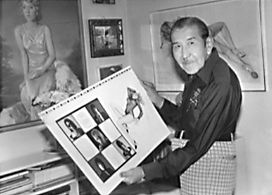Joaquin Alberto Vargas Chavez was born in Peru in 1896. He was the son
of famous Peruvian photographer Max T. Vargas and was exposed to the airbrush
at an early age. In 1911, he went to Europe to study. In Paris, he discovered his
great artistic idol, Raphael Kirchner. Kirchner was an Austrian portrait painter and illustrator. He was best known for his Art Nouveau and early pin-up work. Kirchner's technique and approach to the female figure profoundly influenced Vargas. In 1916, instead of starting an apprenticeship at the photography house in England, Vargas moved to New York, where Kirchner was working as a staff artist of the Ziegfeld Follies.
In New York, he began drawing and painting while retouching photographs for a living. Vargas became the primary Ziegfeld artist in 1919 after Kirchner died in 1917. He painted portraits of all the stars of each season's Broadway production during this time. Vargas developed the tone of his art: the idealized depiction of women, glorified but never vulgarized.
Vargas was never a very successful businessman. In 1930, when he married his wife, Anna Mae, he had to borrow money to pay for the marriage license. The Follies' work ended in 1931. During the 1930s, he had low-paying positions in the art departments of various Hollywood studios in California.
In 1940, when he returned to New York from California, Esquire hired him to replace George Petty, the magazine's principal artist. He became famous as "Varga" in the 1940s as the creator of iconic World War II-era pin-ups, known as "Varga Girls", for Esquire magazine. It was "Varga" who was famous. In 1950, a legal dispute with Esquire over the use of the name. The decision was that Esquire owned the moniker. Following this lawsuit, he struggled financially to raise himself from the ashes until later, when he started working for Playboy in the 1960s.
During the lean times of the late 1940s and 1950s, he painted the "Legacy Nudes" as an "insurance policy" for his wife. Sadly, she died before him. In the early 1950s, Vargas issued his deck of playing cards, "Vargas Vanities," and did some starlet paintings in True magazine and other minor efforts. From 1954 to 1957, he had a monthly feature in an
obscure British men's magazine. A pictorial in Playboy in 1957 and a trip home to Peru
in 1958 provided much-needed emotional relief, but the late '50s were a time of no work.
Vargas used the time to perfect his skills, and when Hugh Hefner hired him in 1960 to
paint foldout nudes for Playboy; he was ready.
At the age of 64, Vargas began a new career that would finally give him the respect and financial security he merited. He worked for Playboy for 16 years, during which time he produced 152 paintings. Many were masterpieces, but the constant need to create glamorous pictures of sexy 19-year-olds month after month often resulted in some formulaic and occasionally perfunctory work.
The death of his wife, Anna Mae, in 1974 left him devastated and led to his retirement in 1976. In 1978, with Reid Austin, Vargas published "Alberto Vargas," a compelling tale of his life profusely illustrated
with rare, classic, and even some previously unseen images. The publication of
his autobiography renewed interest in his work and brought him partially out of his
self-imposed retirement to do a few works, such as album covers for Bernadette
Peters and the Cars. ("Candy-O")
He died of a stroke on Dec. 30, 1982, at the age of 86.
Many of Vargas' works from his period with Esquire were given to the Spencer Museum
of Art at the University of Kansas in 1980.






Photographs of Ziegfeld Follies showgirls in the 1920s taken by Alfred Cheney Johnston


